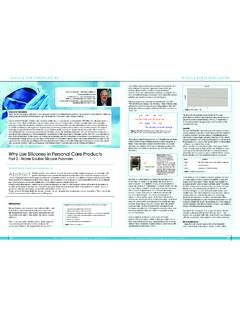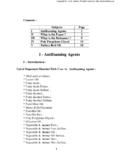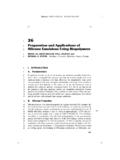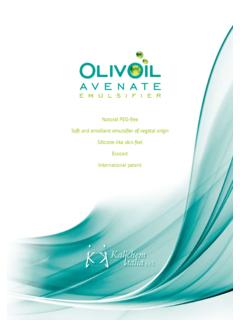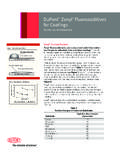Transcription of The Silicone Conundrum - Scientific Spectator
1 The Silicone Conundrum Editors Note: The last edition of The Silicone Spectator began to address The Silicone Conundrum . The term Conundrum is defines as an intricate and difficult problem. The problem is how do I get the highly desirable properties of Silicone in my formulation, when formulating with Silicone can provide its owe set of problems? This edition will address two key areas: (1) selecting the proper Silicone for a specific application; and (2) Silicone resins, and elastomers . Silicones in Formulation Silicone surfactants are amphilic nature and consequently lower surface tension of water1.
2 The reduction of surface tension is a necessary first step in the providing foam, emulsification, wetting and other surfactant properties. Each of these surfactant properties require a material that lowers surface tension. Put another way, all materials that foam, emulsification, or wetting lower surface tension, but not all materials that lower surface tension provide these properties. The structure of the molecule at the surface that lower surface tension determines which molecule functions in a particular way. The function of a Silicone compound, in this case a dimethicone copolyol, alone in aqueous solution while of academic interest, is of limited interest to a formulator.
3 This is due to the fact that formulations are never simply water and dimethicone copolyol, The key to formulation is the interactions between the surfactants and other ingredients that alter the performance of the surfactants at the surface. There are interactions between different formulation components and understanding them and optimizing them for a given effect is key to formulation success. This article will begin to investigate some of the interactions between selected dimethicone copolyol compounds. The materials chosen for evaluation are shown in Table lauryl sulfate (SLS), sodium laureth 2 sulfate (SLES-2) were chosen because they are important materials for use in personal care products.
4 Raw Materials Dimethicone Copolyol CH3 CH3 CH3 CH3. | | | |. CH3-Si-O- (- Si- O )a- (-Si-O )b -- Si- CH3 Silicone Soluble | | | |. CH3 CH3 (CH2)3 CH3. |. O. |. (CH2CH2O)xH Water Soluble Sodium Lauryl Sulfate CH3(CH2)11-SO4 Na Oil Soluble Water Soluble Sodium Laureth 2 Sulfate CH3(CH2)11-(O-CH2CH2)2SO4 Na Oil Soluble Water Soluble Table 1 outlines the molecular weight information, the INCI name and the short hand used to designate the compounds in this article. Table 1. Compounds Evaluated Material Aprox INCI. MW. SLS 320 Sodium Lauryl Sulfate SLES-2 410 Sodium Laureth 2 sulfate DMC-1 700 PEG-8 dimethicone DMC-2 5800 PEG-8 dimethicone DMC-3 2500 PEG-8 dimethicone DMC-4 1620 Bis-PEG-8 dimethicone Surface Tension ( 1% Weight Aqueous Solutions).
5 The surface tension of the various materials was first evaluated. Table 2 lists the results. The table clearly shows that the sulfated fatty alcohol surfactants have a surface tension in the range of 30 32 dynes/cm2. The Silicone surfactants have lower surface tension, in the range of 21- 28 dynes /cm2. The variation of surface tension within the class of Silicone compounds is noteworthy. There has been a tendency to make generalizations that all Silicone surfactants have essentially identical surface tension values. Clearly, this is not the case.
6 As the Silicone molecule contains less and less Silicone in it the surface tension becomes more fatty surfactant like. The orientation on the surface and the groups that one sees at the interface determines the surface tension. The Silicone portion of the molecule has an abundance of methyl groups, (which make the surface tension lower) and the standard surfactant groups have an abundance of methylene groups (-CH2-), which makes the surface tension higher. What is seen at the interface is the group, which predominates at the surface when the molecule is in the lowest free energy conformation.
7 Table 2 shows a graphic representation of a Silicone molecule. The presence of the methyl groups predominate the surface of the polymer. Table 2. Model Silicone Molecule Table 3 shows the surface tension of the pure compounds studied at 1% active in Table 3. 1% Aqueous Surface Tension Dynes/cm2. SLS SLES-2 DMC-1 DMC-2 DMC-3 DMC-4 Table 4 shows graphically the data in table 3. The surface tension of the Silicone is determined by how it orientates at the surface. It is very important to note that all Silicone surfactants do not have the same low surface tension.
8 The desire to place all Silicone compounds into one group in terms of surface tension while simplistic, is simply incorrect. Molecules that have long EO/PO chains have surface tensions like fatty surfactants, not Silicone surfactants. As we will discuss, the performance in formulations is complex depending upon the other components present. Table 4. Surface Tension (dynes/cm2). 35. 31. 30. 25 20 15. 10. 5. 0. SLS. SLES-2. DMC-1. DMC-2. DMC-3. DMC-4. Surface Tension Binary Mixed Systems As one looks at the combination of sodium lauryl sulfate or sodium laureth-2-sulfate with the various dimethicone copolyols, one can envision a number of interactions.
9 Firstly the interactions that occur because of the incompatibilities of the Silicone , fatty and water-soluble groups. Secondly, interactions related to hydrogen bonding and thirdly interactions between polyoxyalkylene groups on those materials that contain such groups. It is the nature of those interactions that will determine the surface tensions on the various blends. DMC SLES 2 Interactions 1% solutions of SLES-2 and different ratios of DMC compounds were made and evaluated for surface tension. Table 5. shows the results. Only one DMC had an impact on the surface tension of the solution.
10 That DMC-1 which is the lowest molecular material we evaluated. DMC-2 through 4 did not alter surface tension. The interaction between the various functional groups in a formulation and the stability of the resulting complexes is critical to functionality of a formulation. If lowering surface tension is the goal of the addition, DMC-1 is the only one of the group to effectively accomplish the goal. Table 5 Surface Tension Blend (@ 1% active ) (dynes/cm). 95% SLES-2/5% DMC-1 90% SLES-2/10% DMC-1 50% SLES-2/50% DMC-1 95% SLES-2/5% DMC-2 90% SLES-2/10% DMC-2 50% SLES-2/50% DMC-2 95% SLES-2/5% DMC-3 90% SLES-2/10% DMC-3 50% SLES-2/50% DMC-3 95% SLES-2/5% DMC-4 90% SLES-2/10% DMC-4 50% SLES-2/50% DMC-4 1% solutions of SLS and different ratios of DMC compounds were made and evaluated for surface tension.
